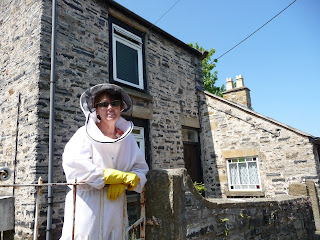24 May 2012: A work day at The Elms in Gronant. Janet repotted seedlings, and Thom and Stuart worked on making some steps up to the top land. Sheila worked in the garden; it was a wonderful sunny day.
 |
| Janet in the "Poly-tunnel" |
 |
| Stuart and Thom on the steps they made. |
 |
| The day ended with a delicious BBQ attended by Stuart's brother Jonathan and his family - Jack, Lindsey, and Dale. Not pictured is 17-year-old Stephen who took Sheila horseback riding. He was out riding "Blue." |
25 May 2012: Stuart and Thom cycled 25 miles to Conwy, and Janet and Sheila joined them there for lunch before they made the return trip home. They wanted to cycle 50 miles, since during their fall trip crossing America they would like to average 50-60 miles per day.
 |
| Sheila and Jan at Conwy Suspension Bridge, Conwy, Wales |
 |
| Here come Stuart and Thom |
 |
| Thom and Stuart on Conwy Suspension Bridge, Conwy, Wales |
 |
| The suspension bridge goes over the River Conwy estuary into the Irish Sea. Note the traffic sign indicates to "Give Way" rather than "Yield." |
 |
| Conwy is reknowned for its mussels... |
 |
| ...and for having the smallest house in Great Britain. |
 |
| Conway also has a castle. |
 |
| And you can be directed to it in English or Welsh. |

























































